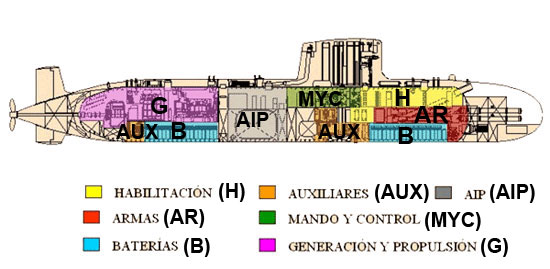S-80 Submarine
Submarines
BACKGROUND
The Strategic Defence Review issued in February 2003, considered the S-80 Submarine a priority programme. This document takes into account the need to procure submarine units to maintain the freedom of action and mobility of the Force with two submarines operating simultaneously in two theatres: one in a far away scenario and another close by. The units will have an air independent propulsion system with land-attack missile capability and important elements for intelligence gathering.
Preliminary studies were carried out between 1989 and 1991. In the year 1997 the programme started following the PAPS method. (Phased Armaments Programming System):
- Assessment of operational requirements resulting in the document “Preliminary Concept of Staff Objectives” published in November 1997.
- Pre-feasibility stage resulting in the document “Staff Objectives” published in April 1998.
- Feasibility stage resulting in the document “Staff Requirements”.
- Project Definition (First Stage): On November 2nd 1999 a contract was signed between IZAR Shipyards in Cartagena and DAM for the definition of a submarine prototype.
Changes in the world strategic situation recommended a review of operational requirements to adapt the submarine to new scenarios and demands. New “Staff Requirements” were approved by the Spanish Chief of Naval Staff in July 2002.
The main changes included the air independent propulsion system (AIP) and land-attack capability.
- Project Definition (Second Stage): In order to implement the new requirements a new contract was signed with IZAR in November 2002.
In March 2004 the Shipbuilding Order was signed between the Ministry of Defence/Spanish Navy and IZAR to build four S-80 Submarines. The main milestones are:
- January 2005: Shipbuilding starts.
- October 2011: Delivery of the first submarine.
- 2012/2014: The whole series is completed.
Silhouette Submarine S-80
Dimensions
- Length: 71 metres.
- Diameter: 7.3 metres.
- Displacement: 2,400 tons.
Propulsion
- Main electric engine: 3,500 kW.
- Diesel power: 3 x 1,200 kW.
- AIP power: 300 kW.
- AIP endurance: 15 days.
Weapons
- 6 torpedo launchers
- Active launching system by means of turbo-pumps.
Complement
- Crew: 32
- Transport personnel: 8
- Total: 40
Combat System
Cross-section of the S-80 Submarine
The mission of the Combat System is to acquire, assess and provide all necessary information for the fulfilment of the mission, as well as controlling the weapons and their launching systems.
From the design point of view, the Combat System is completely integrated. It operates from multi-function console tables with an open, modular and distributed architecture and an extensive use of COTS. From the multi-function console tables the following systems can be controlled: all ship sensors including the information gathered; command and control functions like track management and decision making aids; and weapons launching systems including wire-guided torpedoes.
The S-80 Combat System includes:
- Launching capability of long range land-attack missiles.
- Satellite communication systems and Data Link.
- Short, medium and long range acoustic sensors capable of detecting, classifying, selecting and attacking surface and underwater units and shipping and mine detection.
- Visual, optronic (all-weather) and electromagnetic detection assets which allow the submarine to quietly and stealthily approach, attack and escape, and take part in intelligence gathering operations.
- Navigational aids to carry out specific and precise operations.
- Double purpose long range heavy torpedoes, mines and anti-ship missiles.
Mission profile
- In agreement with the Strategic Defence Review, the Naval Forces, apart from maintaining the control of sovereign maritime spaces and areas of national interest, must be directed towards far away theatres, with a special emphasis in naval power projection. Therefore, naval power projection operations and the protection of army and naval forces in littoral waters are more probable situations than the traditional naval combat.
- The submarine, as part of the naval force, with both, her traditional and state-of-the-art weapons and communication systems, must significantly contribute to those operations.
- To this end, the submarine must be capable of integrating into the Force. Consequently, the ship mounts a real-time reliable and secure communications and information exchange system.
S-80 missions include the following tasks:
- Projection of the naval power ashore.
- Special Naval Warfare.
- Protection of a Landed Force.
- Surveillance (Indication & Warning).
- Protection of a Naval Force.
- Deterrence.
S-80 submarines must face the following threats both in the Atlantic Ocean and the Mediterranean Sea:
- Mine fields.
- Surface ships with active and passive sonars.
- ASW aircraft with radars, active and passive sonobuoys and VDS.
- State-of-the-art nuclear and conventional submarines.
Cross-section of the S-80 Submarine
The following are the main capabilities of the S-80 submarine:
- Operational mobility capable of transiting in stealth and at high speed towards far away scenarios.
- Air independent propulsion system in order to operate discreetly.
- Combat System.
- Transport of personnel.
- Reduced magnetic and acoustic signatures to minimise detection.
- Reduced radar and infrared signatures to minimise detection.




 + 3
+ 3
